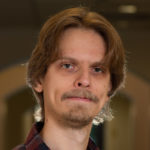
Stanislav Panin holds a PhD in Philosophy from Moscow State University and is a Doctoral Student of the Department of Religion at Rice University
Though I am a scholar of religious studies, I am not an expert in Orthodox Christianity. My specialization is the study of both new religious movements and esoteric communities and their roles in contemporary culture. With such unusual interests, it should come as no surprise that my interests in Russian media coverage of Ukrainian autocephaly were equally unusual. For many years, I have observed that polemical narratives against emerging or unorthodox spiritual communities are more than just random attacks. Particularly within the Russian context, most of these criticisms uncover broader political ideologies that universally characterize religious groups as the enemy, building the foundation for large-scale ideological criticism not limited only to religion.
Brief History of the Term “Sect”
To illustrate, consider the language of “sects” that is routinely used in a modern-day Russia to denote groups that fall outside the mainstream. The term “sect” was originally popularized among academics through works of Max Weber and Ernst Troeltsch.[1] These scholars used the term to define Christianity within a specific historical context including state churches, legal limitations of religious freedom, and predominantly Christian populations. These three factors are necessary to make a church–sect classification useful, and even then, one might need to introduce additional categories such as “denominations” or “mysticism” to account so many manifestations of the faith. With growing separation of Christian churches from Western states and the advancement of religious pluralism, more and more scholars have argued that the old sociological classifications are problematic. To quote Allan W. Eister’s 1967 article, “efforts at church–sect conceptualization have, to date, produced only a jumble of confused and often contradictory assertions, lacking both reliability and common acceptance by sociologists.”
However, the term “sect,” has another theological dimension. The Latin term secta was popularized during the fourth century in conjunction with the Latin translation of the Bible which corresponded to the Greek αιρεσις, meaning heresy, a word with clearly negative connotations. During Westernization and modernization of Russian society initiated by Peter the Great, the term was adopted by eighteenth-century Russian theologians as a replacement for “heresy.” Thus, this sense of deviation from presumed theological norms permeates the term “sect” in Russian culture.
The Rhetoric of Sects in Contemporary Russia
After the collapse of the Soviet Union and subsequent religious revival in the late 1980s, the term “sect” grew in prominence within Russian Orthodox theology. For the first time in history, the Russian Orthodox Church faced religious pluralism and in reaction, modern Orthodox theology incorporated some aspects of the Western European and North American anti-cult movement and constructed the term “sect” that primarily targeted new religious movements (similarly to the term “cult” in Anglophone context).
This vague, but clearly negative construction allowed for demonizing unconventional religious bodies as if they were enemies, a useful new tool for Russian political groups to encourage anti-Western rhetoric during the latter half of the 2010s. In 2016, conservative author Mikhail Demurin went as far as using “sect” to refer to the West generally in an article published in REGNUM. Even beyond this extreme example, the word “sect” appears as a polemical device over and over again in media, during sessions of Russian parliament, in heated online debates, and in everyday conversation.
The Ukrainian Autocephalous Church as a “Sect”
Regarding the situation in Ukraine, Russian media has employed this rhetoric of “sects” to describe the conflict with Ukraine on many levels. For example, independent Ukrainian Orthodox groups were described as sects, by both mainstream and marginal media outlets, based on their separation from the Moscow Patriarchate. The RIA Novosti published an article by Nyura Berg entitled “This Tomos is already Broken” explaining a conflict between the Orthodox Church of Ukraine’s hierarchs, Filaret and Epiphany, as a clash between leaders of “schismatic sects.”The same description, “schismatic sects,” was used by Alexander Grishin in Komsomol’skaya Pravda, while the more conservative Tsar’grad incited nationalism when referring to the “sectarian” nature of the Orthodox Church of Ukraine and the Ukrainian Orthodox Church.
More elaborate narratives combine Cold War rhetoric surrounding the perils of the West, nostalgia for the Soviet Union, respect for conservative Orthodox Christianity, anti-cult narratives, and criticism of the Ukrainian government. For instance, an article on News Front , written by Crimean pro-Russian activist Konstantin Knyrik, begins by connecting Ukrainian presidents Viktor Yushchenko and Petro Poroshenko with Slavic Pagan religious movements, claiming that Ukrainian Paganism was created artificially in the United States. The article further denounces Ukrainian attempts to achieve autocephaly as inspired by Western influence, citing a connection between the Roman Catholic Church and Ecumenical Patriarch Bartholomew, a key supporter of Ukrainian autocephaly, in a strategic game against the Russian Orthodox Church and even Russia itself.
Studying new religious movements and the discourse around them is therefore crucial not only for its own sake, but also to understand broader political phenomena. Targeting “strange” and “exotic” forms of spirituality is often neglected as insignificant or irrelevant, but any language indicating “otherness” can certainly be applied to whomever one deems an opponent. Thus, a language of “sects” that was constructed initially against non-Orthodox religious movements is easily revised to attack rival Orthodox churches over theological disagreement, political statements criticizing the Ukrainian government, and ultimately, to expose, as Demurin wrote in the abovementioned article, the “totalitarian sect of the West.”
[1] Troeltsch, Ernst. The Social Teaching Of The Christian Churches. (New York: The Macmillan Company, 1931), 331ff.
